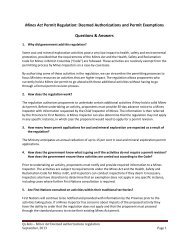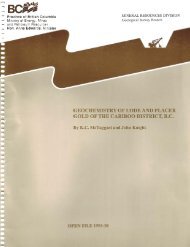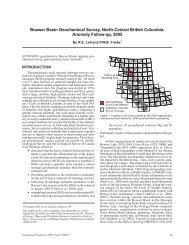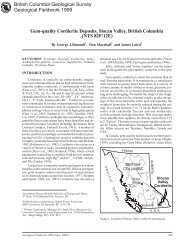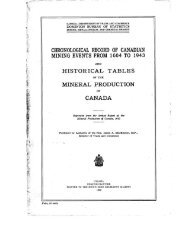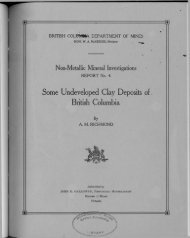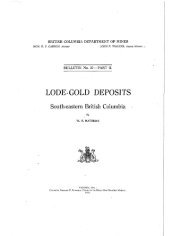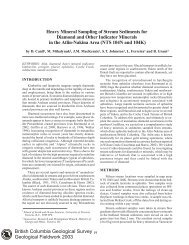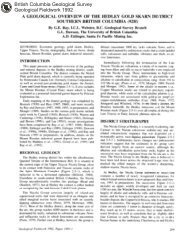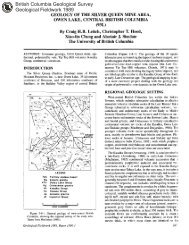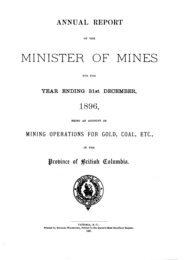PDF version - Ministry of Energy, Mines and Natural Gas
PDF version - Ministry of Energy, Mines and Natural Gas
PDF version - Ministry of Energy, Mines and Natural Gas
You also want an ePaper? Increase the reach of your titles
YUMPU automatically turns print PDFs into web optimized ePapers that Google loves.
Mineral Occurrence<br />
ALUNITIC ALUN<br />
ARGILLIC ARGI<br />
Introduction <strong>of</strong>, or replacement by, ALUNITE. This alteration is caused by extreme hydrolytic leaching <strong>of</strong><br />
wallrocks in the presence <strong>of</strong> sulphate. The conditions are oxidizing with an abundance <strong>of</strong> sulphate ions. The<br />
most common mineral assemblage is ALUNITE with some form <strong>of</strong> silica: QUARTZ, CHALCEDONY,<br />
CRISTOBALITE, TRIDYMITE, or OPAL. Other minerals present commonly include KAOLINITE, SERICITE,<br />
DIASPORE, BARITE, JAROSITE, RUTILE, ZUNYITE, PYRITE, <strong>and</strong> HEMATITE.<br />
Intermediate argillic alteration is the replacement or alteration <strong>of</strong> feldspars to form predominantly clay<br />
minerals. These include the KAOLINITE group: DICKITE, KAOLINITE, HALLOYSITE, <strong>and</strong><br />
METAHALLOYSITE; the SMECTITE (MONTMORILLONITE) group; the ILLITE group; <strong>and</strong> the amorphous<br />
clays (ALLOPHANE). Mineral assemblages characteristic <strong>of</strong> advanced argillic alteration caused by<br />
hydrothermal solutions at low <strong>and</strong> moderate temperatures are dominated by KAOLINITE group clay minerals.<br />
DICKITE, KAOLINITE, DIASPORE, <strong>and</strong> PYROPHYLLITE may occur with SERICITE, QUARTZ, ALUNITE,<br />
PYRITE, TOURMALINE, TOPAZ, ZUNYITE, <strong>and</strong> AMORPHOUS CLAYS (ALLOPHANE).<br />
BIOTITE BIOT Introduction <strong>of</strong>, or replacement by, BIOTITE.<br />
CARBONATE CARB<br />
CHLORITIC CLOR<br />
DEUTERIC<br />
(AUTOMETASOMATISM) DEUT<br />
EPIDOTE EPID<br />
FENITIC FENT<br />
GREISEN GRSN<br />
HEMATITE HEMT<br />
LEACHING LECH<br />
OXIDATION OXID<br />
POTASSIUM SILICATE<br />
(POTASSIC)<br />
KSPA<br />
PROPYLITIC PROP<br />
Introduction <strong>of</strong>, or replacement by, CARBONATES. Magnesium, iron, calcium, <strong>and</strong> manganese carbonates<br />
are common. These are CALCITE, DOLOMITE, ANKERITE, <strong>and</strong> SIDERITE.<br />
The replacement by, con<strong>version</strong> into, or introduction <strong>of</strong> CHLORITE. This alteration may result from a number<br />
<strong>of</strong> disparate metasomatic processes. Mineral assemblages comprise CHLORITE, with subordinate SERICITE,<br />
QUARTZ, <strong>and</strong> PYRITE.<br />
A process involving reactions between primary magmatic minerals <strong>and</strong> the water-rich solutions that separate<br />
from the same body <strong>of</strong> magma at a late stage in its cooling history. These processes may result in<br />
SILICIFICATION, SODIUM SILICATE (ALBITIZATION), POTASSIUM SILICATE, TOURMALINIZATION <strong>and</strong><br />
GREISENIZATION as pervasive, selectively pervasive, cavity filling <strong>and</strong>/or vein-controlled modes <strong>of</strong> alteration.<br />
The hydrothermal introduction <strong>of</strong> EPIDOTE into rocks or the alteration <strong>of</strong> rocks in which plagioclase feldspar is<br />
albitized, freeing the anorthite molecule for the formation <strong>of</strong> EPIDOTE <strong>and</strong> ZOISITE, <strong>of</strong>ten accompanied by<br />
chloritization. These processes are characteristically associated with metamorphism.<br />
Widespread alkali metasomatism <strong>of</strong> quartz<strong>of</strong>eldspathic country rocks in the environs <strong>of</strong> carbonatite complexes<br />
<strong>and</strong>/or alkalic igneous rocks. FENITES are characterized by FELDSPATHOIDS, <strong>and</strong> ALKALI FELDSPARS<br />
(POTASH FELDSPAR, ALBITE), PYROXENES (AEGERINE, AEGERINE-AUGITE), <strong>and</strong> AMPHIBOLES<br />
(RIEBECKITE-ARFVEDSONITE series).<br />
A type <strong>of</strong> alteration whose minerals are enriched in fluorine, boron, <strong>and</strong> the alkali metals (Na, K, <strong>and</strong> Li). The<br />
characteristic minerals include TOURMALINE, TOPAZ, MUSCOVITE, ZINNWALDITE, FLUORITE, ALKALI<br />
FELDSPARS, <strong>and</strong>/or KAOLINITE.<br />
HEMATITE is the principal mineral product <strong>and</strong> varieties may be granular, specular, or more rarely, earthy.<br />
The latter is generally <strong>of</strong> supergene origin <strong>and</strong> is associated with clay minerals. The style <strong>of</strong> hematite<br />
alteration is pervasive, selectively pervasive, <strong>and</strong> vein-controlled.<br />
The separation, selective removal, or dissolving-out <strong>of</strong> soluble constituents from a rock, soil, or orebody by the<br />
natural action <strong>of</strong> percolating water.<br />
A process whereby an area is modified by surface waters, <strong>and</strong>/or reaction with oxygen (e.g., sulphides altered<br />
to oxides <strong>and</strong> carbonates). A GOSSAN represents an oxidized zone formed by the oxidation <strong>of</strong> sulphides <strong>and</strong><br />
the leaching-out <strong>of</strong> the sulphur <strong>and</strong> most metals, leaving hydrated iron oxides <strong>and</strong> rarely sulphates. Minerals<br />
include LIMONITE, HEMATITE, <strong>and</strong> others.<br />
Hydrothermal alteration resulting from potassium metasomatism, commonly accompanied in calcalkaline<br />
rocks by removal <strong>of</strong> calcium <strong>and</strong> sodium. Characteristic major minerals are POTASSIUM FELDSPARS<br />
(ADULARIA, ORTHOCLASE, MICROCLINE), BIOTITE or CHLORITE, SERICITE, <strong>and</strong> QUARTZ, with<br />
common ALBITE, ANHYDRITE, FE-MG CARBONATE, <strong>and</strong> APATITE.<br />
The result <strong>of</strong> low pressure-temperature alteration. The propylitic assemblage consists <strong>of</strong> EPIDOTE,<br />
CHLORITE, ZOISITE, CLINOZOISITE, SERICITE, MG-FE-CA CARBONATES, PYRITE, <strong>and</strong> sometimes<br />
ALBITE-ORTHOCLASE, all involved in partial replacement <strong>of</strong> wallrock minerals. HEMATITE, JAROSITE, <strong>and</strong><br />
GOETHITE are also common.<br />
PYRITE PYRT Introduction <strong>of</strong>, or replacement by, PYRITE. A common process <strong>of</strong> hydrothermal alteration.<br />
QUARTZ CARBONATE QZCA<br />
LISTWANITE. A mineralogic assemblage that results from the carbonatization <strong>of</strong> serpentinized ultramafic<br />
rocks. A distinctive alteration suite consisting <strong>of</strong> green chromium-bearing mica (MARIPOSITE, FUCHSITE)<br />
with QUARTZ, CARBONATE, LIMONITE <strong>and</strong> MAGNESITE.<br />
file:///C|/HardcopyManual/05_codemino.htm (3 <strong>of</strong> 10)2007-09-20 4:09:05 PM



